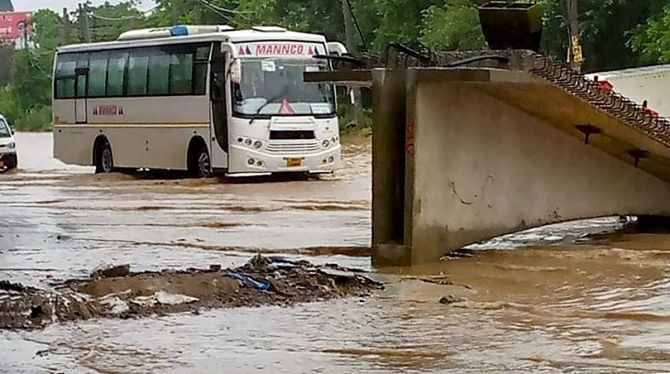Rains continued to lash the national capital and neighbouring areas on Thursday morning, triggering long traffic snarls, uprooting trees and causing damage to property in many areas.

The Ayanagar weather station recorded 122.8 mm between 8.30 am on Wednesday and 8.30 am on Thursday, which was 11 times the normal rainfall.
On an average, the city gauges 11.3 mm rainfall from 8.30 am on August 19 to 8.30 am on August 20 every year.

The Safdarjung Observatory, which provides representative figures for the city, recorded 54.8 mm rainfall.
The Palam, Lodhi Road and Ridge weather stations gauged 89.1 mm, 62.4 and 77.3 mm precipitation during the period.

Rainfall recorded below 15 mm is considered light, between 15 and 64.5 mm is moderate and above 64.5 mm is heavy.

Kuldeep Srivastava, the head of the India Meteorological Department's regional forecasting centre, said moderate rains will continue till Friday morning. Thereafter, the intensity will decrease and the city will witness on and off light rains.
Another spell of moderate rain will begin from August 25, Srivastava said.
The Safdarjung Observatory has recorded 202.2 mm rainfall against the normal of 176.5 mm in August so far -- 15 per cent excess rainfall.
SEE: Roads of Gurugram submerged
Overall, it has recorded 520.8 mm rainfall, 15 per cent more than the normal of 452.6 mm since June 1 when the monsoon season starts.
The Delhi Traffic Police remained busy clearing traffic on Narela-Bawana road, Raja Garden flyover, Kasturba Underpass, MB Rad, Jhandewalan Mandir, Jhilmil underpass, Azadpur vegetable market, Sarai Pipal Thala, Jahangirpuri, Madanpur Khadar among other places.

Similar scenes played out on Wednesday, as incessant rains pummeled the national capital region, submerging roads, underpasses and parks in waist-deep water and bringing traffic on key stretches to a virtual halt.
The flooding was particularly severe in Gurugram, where roads turned into small rivers and parks resembled swimming pools.

Just a few hours of rains flooded swatches of Delhi, spelling trouble for commuters who remained stuck for hours on water-logged roads.

Pictures and videos of vehicles and people wading through waist-deep water were widely shared on social media.
The rains also crippled electricity supply in many areas. Civic bodies reported incidents of uprooting of trees in a few areas due to the rains.

A boundary wall of a school in Saket collapsed, damaging several vehicles parked alongside it.
Mahesh Palawat of Skymet Weather, a private forecasting agency, said climate change had led to a change in rain pattern.
"Earlier, we used to witness continuous light rains over the two-three days. Nowadays, the same quantum of rainfall occurs in just 2-3 hours. These extreme events have been taking place across the tropical region since the last 10 years," he said.












 © 2025
© 2025